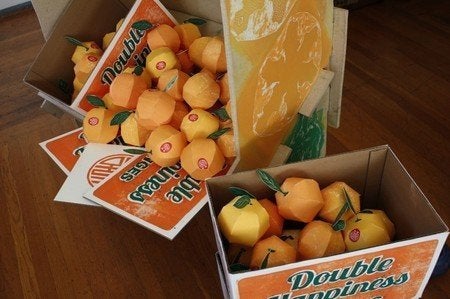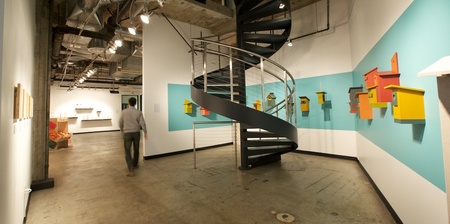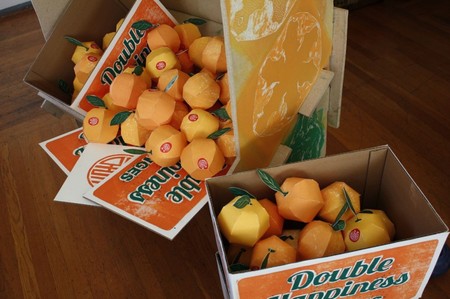

By-Product Becomes Product Exhibition at Intersection for the Arts, San Francisco, CA. Photo courtesy of Scott Chernis.
Artists are working in the decade of Fab or fabrication. With the help of Computer-Aided Design we are producing wood furniture, art and decor at a rapid rate. In order for cost and supply to keep up with the demand artists often use cheap and accessible materials such plywood, particleboard and Medium Density Fiberboard (MDF). Examples of such constructed products would be IKEA furniture or cut out designer decor. What these products don't tell you are the makeup of MDF board is toxic. A resin made with a Formaldehyde base seals up the wood product to make large even sheets. Although these sheets seem ideal for artists who are looking for a cheap base and product that is malleable, it can also emit toxic gases. According to the Environmental Protection Agency, Formaldehyde, can cause asthma and in some cases even cancer in both humans and animals. This leads to the question, if Formaldehyde is so bad for you then why don't we stop using MDF? What is the alternative?
A product is being developed out of the Forest Products Laboratory at the University of Wisconsin collaborating with artist Christine Lee and US Department of Agriculture's John F. Hunt. The product in process is a MDF alternative using no resins and a combination of biodegradable and recycled materials such as used cardboard, cow manure and sawdust. In order to test this product Lee partnered with San Francisco's Intersection for the Arts and five California artists including Russell Baldon (sculpture, furniture), Julia Goodman (paper, sculpture), Barbara Holmes (sculpture, furniture), Scott Oliver (sculpture, public art), and Imin Yeh (printmaker), to put the work to the test.
The result of the artists working with this new board is in an exhibition By-Product Becomes Product that runs February 6 - March 30 in San Francisco, CA. Kevin Chen, Program Director of Visual Arts at Intersection for the Arts, mentions, "Artists are using the same material as the construction trade, but artists are able to use their magic to transform ordinarily material into something that is a wow drop dropping moment to create something really beautiful."
Bring an artist in from the start. It is not often that an artist enters an engineering lab at the beginning of the process of development. This is equally as true when an artist begins to develop and concept often times they do not have the resources to put together a team of engineers and scientists. Perhaps this is the new collaborative model. Hunts experience working with Lee brings up the importance of collaboration on both sides:
Lee has brought a different yet equally valid artists perspective of how does the material work. How do the boards interact with other materials, its finishes, aesthetic features, ... an artistic touch to the questions of developing and using a new material and exploring its abilities and limits? Lees' input has also opened up other avenues of disseminating green technology. From my side, I would be presenting results of the boards at technical conferences with other like researchers or in peer reviewed technical journals. Whereas Lee has opened up different venues for presenting a new material that I was not aware of. Her connections have opened up new discussions to 'get the word' out that there is a new 'board in town' that may have some unique properties and opportunities. These new venues provide exposure to new contacts that I would not necessarily interact with based on my circles of work.
Ultimately the product needs to be tested. The artists working with Lee and Hunt were required to take notes, give feedback and were allowed to use the product in their personal preference of media. Printmaker, Imin Yeh, describes working with the board, "This board actually has this dotted texture which I did not expect. In relief printmaking the texture of the board plays a huge role in the print, so this caught me by surprise. It was difficult to negotiate the fact that there was no smooth surface. The board carved well, but during the printing it did not hold up to the pressure of the press, I lost a lot of clean lines. Also the wood absorbs much more ink than regular wood board, so it took much more material then expected. So the result was a very bumpy surface that was uneven in printing. That was frustrating."
With the feedback from the participating artists, The Forest Products Laboratory with Hunt and Lee will continue to refine the board product. This alternative board is not available for the consumer market at this time. It is a commendable effort and should be an example for other green material manufacturers to consider bringing an artist into the early stages of development.
